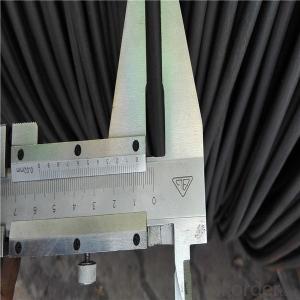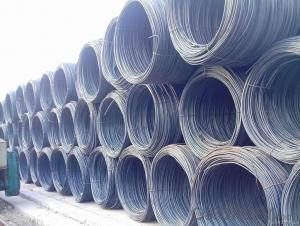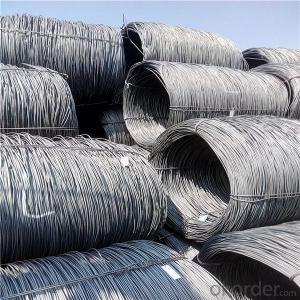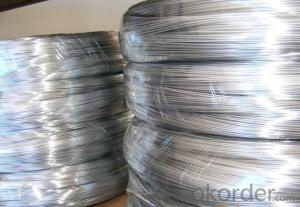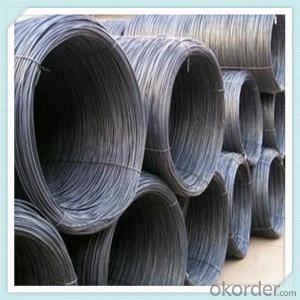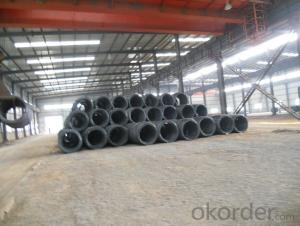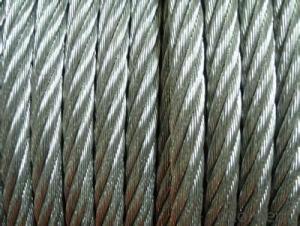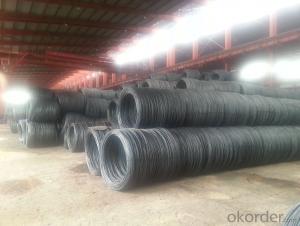Carbon steel wire rod from China mill hot sale
- Loading Port:
- Shanghai
- Payment Terms:
- TT OR LC
- Min Order Qty:
- 100 m.t.
- Supply Capability:
- 15367 m.t./month
OKorder Service Pledge
OKorder Financial Service
You Might Also Like
Specification
Wire rod is a rolled alloy or nonalloy steel product, produced from a semi (e.g. bloom) and having a round,
rectangular or other cross-section. Particularly fine cross-sections may be achieved by subsequent cold
forming (drawing). Wire rod is wound into coils and transported in this form. .
Mainly used in building and construction as binding wire, tie wire and baling wire; also can be make for wire mesh.
Our Advantage: High quality steel products from 1 class mills in
Reasonable price
Professionalism of the products
On-time delivery
Complete documents and certificates
Sincere service to meet our clients' requirements
Product Description :
Standard | AISI, ASTM, BS, DIN, GB, JIS |
Material/steel grade | Q195-Q235,SAE1006B,SAE1006CR, SAE1008B, SAE1008CR, SAE1010B, SAE1018B, or according to customers requirements |
Wire Gauge | 5.5-12mm |
Coil weight | 1.8-2.1mts |
MOQ | 25MT |
Delivery Time | 15-30 days after receipt of L/C or deposit by T/T |
Packing | In coil and load in container, if large quantity, by bulk vessel; Can be packed as customers' special requirements |
Payment terms | 1).100% irrevocable L/C at sight. 2).30% T/T prepaid and the balance against the copy of B/L. 3).30% T/T prepaid and the balance against L/C |
Application | widely used in machinery parts, manufacturing industry, electronics industry, metal tools and others |
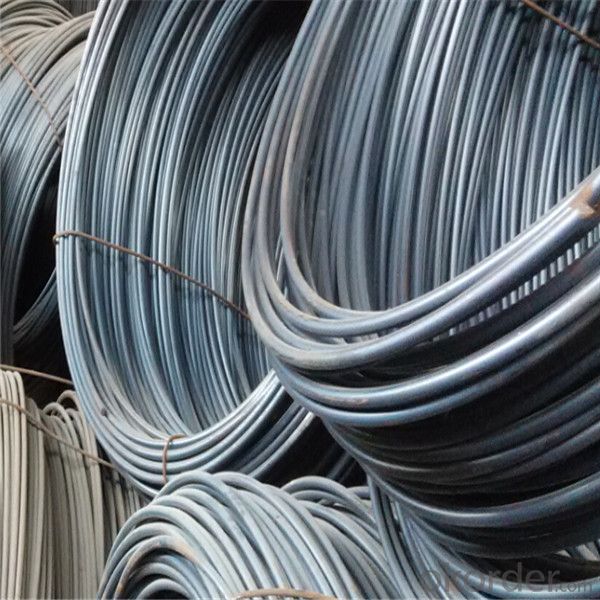
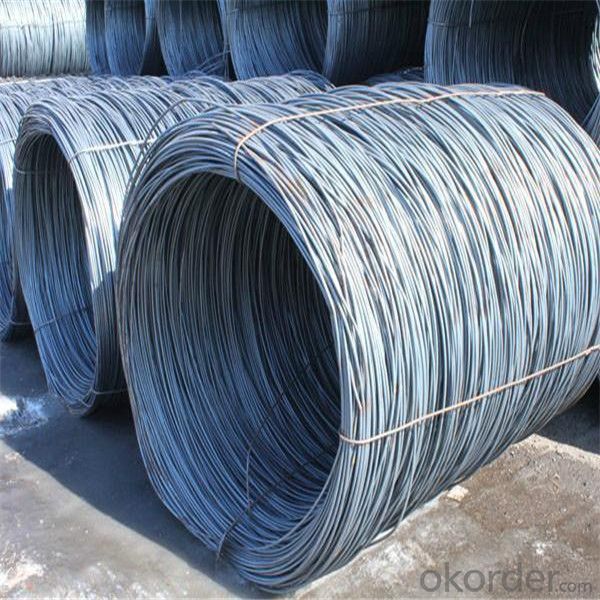
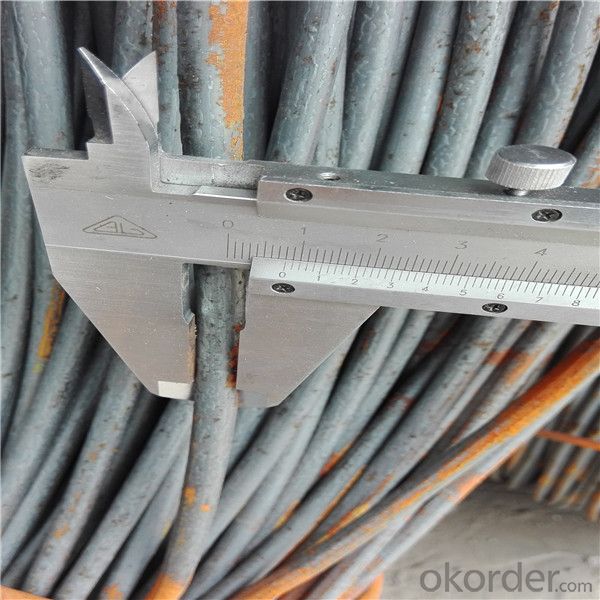
Application :
It generally used in braiding the hose for bathing product and machinery. With it
good flexibility, resistant to high temperature and resistant to corrosion, it
used widely in many industries.
Packing :
Hot-rolled wire rod is held in a unit with at least four steel straps in the
transverse direction and transported and stored without further packaging.
Before
the steel strapping is applied, the wire rod must be sufficiently compressed.
The strapping is fixed in the transverse direction with a single circumferential
strap so that the strapping does not slip and cause the coil to come apart.
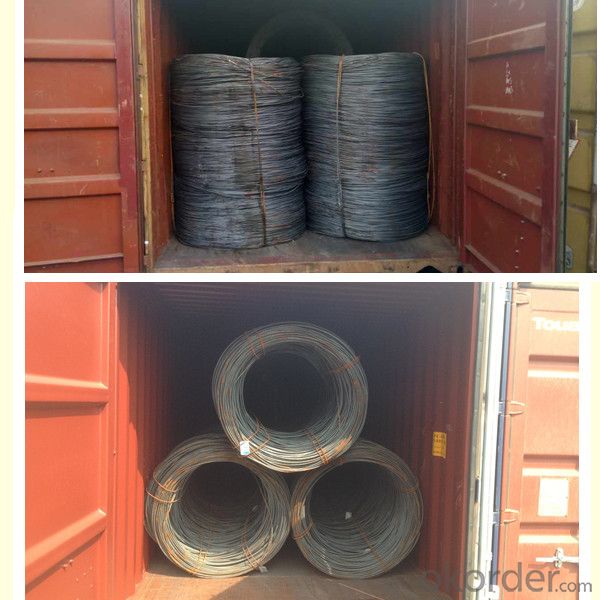
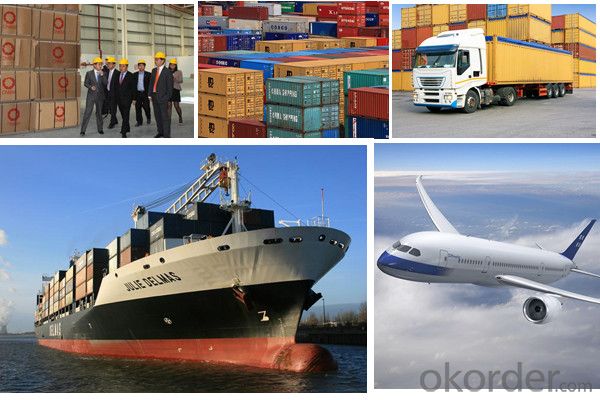
Our service:
(1) We cooperate with famous factories with advanced equipment and well trained workers.
(2) We can provide factory price with trading company service.
(3) We continuously work on the improvement of our processes, guaranteeing
consistently high standards of quality to keep none compensation.
(4) We guarantee 24 hours response and 48 hours solution providing service.
(5) We accept small order quantity before formal cooperation.
(6) We deliver the agreed quality at the agreed time, reacting to changes in
customer wishes in a flexible way.
(7) Due to our volume and selling power, we have excellent freight rates with
shipping lines.
(8) We strive to always be fair and honest in our dealings with customers.
(9) We strive to work together with customers to achieve much more than we can
achieve alone.
(10) Through our passion and commitment we aim to be a market leader in all our
key markets. To maintain our position as market leader we must continue to add
value in all that we do.
FAQ:
1.Q: What's your MOQ(minimum order quantity)?
A: One full container, mixed acceptable .
2. Q: What's your packing methods?
A: Packed in bundle or bulk ..
3. Q: How can I buy CNBM products in my country?
A:Please send us an inquiry or email ,we will reply to you if there is distributor in your country
4. Q: Can we visit your factory?
A: Warmly welcome. Once we have your schedule, we will arrange the
professional sales team to follow up your case.
5. Q: How long does it take to get the product if i place an order?
A:With the process of your requirements,we will pack and deliver in 3
-7 days. If it is by sea shipment,it will take 15-45 days depending on different locations
- Q: What are the common sizes of steel wire rods?
- The common sizes of steel wire rods vary depending on their intended use and application. However, some commonly available sizes range from 5.5mm to 32mm in diameter.
- Q: What are the common raw materials used in steel wire rod production?
- The primary raw materials utilized in the production of steel wire rods are iron ore, coal, and limestone. Steel production heavily relies on iron ore, which is acquired through mining. Coal is utilized as a fuel during the steelmaking process to generate the necessary heat and energy. Limestone is introduced into the steelmaking process as a fluxing agent, aiding in impurity removal and slag formation. Furthermore, different alloying elements like chromium, nickel, and manganese may be incorporated into the steel to attain desired properties. These raw materials play a critical role in manufacturing top-notch steel wire rods that find extensive applications in industries such as construction, automotive, and manufacturing.
- Q: How is steel wire rod used in the manufacturing of wire ties for construction sites?
- Steel wire rod is a vital component in the production of wire ties used on construction sites. These wire ties are extensively utilized in the construction industry for multiple purposes, such as securing rebar, reinforcing concrete structures, and fastening construction materials together. The steel wire rod acts as the primary material for manufacturing wire ties. It goes through a series of processes to transform it into the final product. Initially, the wire rod undergoes cleaning and coating to enhance its resistance to corrosion. This coating, commonly composed of zinc, provides an additional layer of protection against rust, ensuring the longevity of the wire ties in harsh construction environments. Following that, the coated steel wire rod is fed into a wire drawing machine, where it is pulled through a die to reduce its diameter to the desired size. This process is repeated multiple times to achieve the required thickness and strength of the wire. Once the wire is drawn to the desired gauge, it is then cut into appropriate lengths to produce individual wire ties. These lengths may vary depending on the specific application and requirements of the construction project. Using specialized machinery, the wire is then bent, twisted, or formed into the shape of a tie. Wire ties made from steel wire rod offer exceptional strength, durability, and flexibility. They can be easily bent or twisted to fit around various construction materials, ensuring a secure and tight connection. Furthermore, the high tensile strength of steel wire rod guarantees that the wire ties can withstand significant stress and load without breaking or deforming. Wire ties manufactured from steel wire rod are commonly employed on construction sites to secure and fasten rebar during concrete pouring. They are also utilized to reinforce concrete structures, such as walls, columns, and beams. Additionally, wire ties are used to bundle or tie together construction materials, including pipes, cables, and electrical wires, ensuring proper organization and minimizing potential hazards. In conclusion, steel wire rod plays a critical role in the production of wire ties for construction sites. These wire ties provide essential support and reinforcement in various construction applications, offering durability, flexibility, and strength to ensure the safety and stability of construction projects.
- Q: How are steel wire rods used in the production of fishing lines?
- To enhance the strength and durability of fishing lines, steel wire rods are employed. These rods act as the backbone of the line, granting it the tensile strength needed to endure the pressure and weight imposed by sizeable fish. Typically crafted from top-notch stainless steel, the steel wire rods employed in fishing lines possess resistance to rust and corrosion. This characteristic is crucial since fishing lines are consistently exposed to water and moisture, which can lead to material deterioration over time. Throughout the manufacturing process, a protective layer, such as nylon or polymer, is applied to the steel wire rods. This coating not only bolsters their performance but also renders them more suitable for fishing purposes. It not only contributes added strength but also enhances the line's flexibility, facilitating easier casting and retrieval. Additionally, the steel wire rods determine the overall diameter and weight of the fishing line. Thicker rods result in a heavier and stronger line, while thinner rods produce a lighter and more sensitive one. This enables anglers to select a fishing line that aligns with their specific requirements and fishing conditions. Moreover, the incorporation of steel wire rods into fishing lines amplifies sensitivity, enabling anglers to detect even the most subtle nibbles or movements by fish. This proves especially advantageous in situations where fish are more cautious and necessitate a delicate approach. In conclusion, steel wire rods play a critical role in the production of fishing lines. They provide the essential strength, durability, and sensitivity required, serving as the foundation of the line to withstand the weight of large fish and resist the detrimental effects of water and corrosion.
- Q: What are the common industry seminars for steel wire rod?
- Some common industry seminars for steel wire rod include conferences on wire and cable manufacturing, steel industry exhibitions, and workshops on steel wire rod production techniques. These events provide opportunities for professionals to network, learn about new technologies and trends, and exchange knowledge and best practices in the field of steel wire rod.
- Q: How does steel wire rod compare to other materials for wire production?
- Steel wire rod is widely regarded as one of the most suitable materials for wire production due to its exceptional strength, durability, and versatility. Compared to other materials, such as aluminum or copper, steel wire rod offers superior tensile strength and resistance to corrosion, making it ideal for various applications. Additionally, steel wire rod can be easily shaped, welded, and drawn into different wire sizes and forms, ensuring its compatibility with diverse industries like construction, automotive, and manufacturing. Its cost-effectiveness and widespread availability further contribute to its preference over other materials in wire production.
- Q: What are the different types of steel wire rod coatings used for electrical conductivity?
- There are several different types of steel wire rod coatings used for electrical conductivity, each with its own unique characteristics and advantages. One common type of coating used for electrical conductivity is copper. Copper has excellent electrical conductivity properties, making it an ideal choice for applications requiring high electrical performance. Copper coatings can be applied through various methods such as electroplating or hot-dipping, ensuring a uniform and durable coating on the steel wire rod. Another type of coating used for electrical conductivity is silver. Silver is known for its exceptional electrical conductivity, even better than copper. It is often used in applications where the highest level of electrical performance is required, such as in high-frequency cables or precision electronic components. Silver coatings can be applied through electroplating or electroless plating processes, providing a thin and highly conductive layer on the steel wire rod. Zinc is another commonly used coating for electrical conductivity, although it may not possess the same level of conductivity as copper or silver. Zinc coatings are often used for corrosion protection in electrical applications, as they provide a sacrificial layer that prevents the underlying steel wire rod from corroding. Additionally, zinc coatings can also enhance the electrical conductivity of the steel wire rod to some extent. Tin coatings are also utilized for electrical conductivity purposes. Tin is known for its low electrical resistance and good corrosion resistance properties. Tin coatings can be applied through electroplating or hot-dipping processes, providing a reliable and conductive layer on the steel wire rod. Lastly, there are also specialized coatings such as nickel or gold that can be used for specific applications requiring unique electrical conductivity properties. Nickel coatings offer good electrical conductivity and corrosion resistance, making them suitable for various electrical and electronic applications. Gold coatings, on the other hand, are highly conductive and provide excellent corrosion resistance, making them ideal for high-end electronic components or connectors. In conclusion, the different types of steel wire rod coatings used for electrical conductivity include copper, silver, zinc, tin, nickel, and gold. Each coating offers specific advantages and is chosen based on the desired level of electrical performance, corrosion resistance, and application requirements.
- Q: What are the different high-temperature properties of steel wire rod?
- Steel wire rods have several high-temperature properties that make them suitable for various applications. One of the key properties is high thermal stability, which allows the wire rods to maintain their structural integrity even at elevated temperatures. This is crucial in industries such as automotive and aerospace, where steel wire rods are used in parts that are subjected to high temperatures during operation. Another important property of steel wire rods at high temperatures is their resistance to oxidation. Steel wire rods are typically coated with a protective layer, such as zinc or galvanized coating, which acts as a barrier against oxidation. This prevents the wire rods from corroding and losing their strength when exposed to high temperatures and harsh environments. Furthermore, steel wire rods exhibit excellent mechanical properties at elevated temperatures. They have high tensile strength and good creep resistance, which means they can withstand heavy loads and prolonged exposure to high temperatures without deforming or breaking. This makes them ideal for applications where strength and durability are required, such as in construction and manufacturing industries. Moreover, steel wire rods also have good thermal conductivity, allowing them to efficiently transfer heat. This property is beneficial in applications such as heating elements, where the wire rods are used to generate and distribute heat evenly. In summary, the different high-temperature properties of steel wire rods include thermal stability, resistance to oxidation, excellent mechanical properties, and good thermal conductivity. These properties make steel wire rods a versatile and reliable material for various high-temperature applications in different industries.
- Q: How is steel wire rod used in the manufacturing of wire fencing?
- Steel wire rod is used in the manufacturing of wire fencing as it serves as the primary raw material. The wire rod is first drawn into the desired thickness and then twisted or woven to form the fence structure. The strength and durability of the steel wire rod ensure that the wire fencing is capable of withstanding external forces and providing security.
- Q: What are the main factors affecting the product quality of steel wire rod?
- Some of the main factors affecting the product quality of steel wire rod include the composition and purity of the raw materials used, the manufacturing process and technology employed, the quality control measures implemented during production, and the final inspection and testing procedures conducted. Other factors may include the quality of equipment and machinery used, the expertise and training of the workforce involved, and external factors such as environmental conditions.
Send your message to us
Carbon steel wire rod from China mill hot sale
- Loading Port:
- Shanghai
- Payment Terms:
- TT OR LC
- Min Order Qty:
- 100 m.t.
- Supply Capability:
- 15367 m.t./month
OKorder Service Pledge
OKorder Financial Service
Similar products
Hot products
Hot Searches
Related keywords

